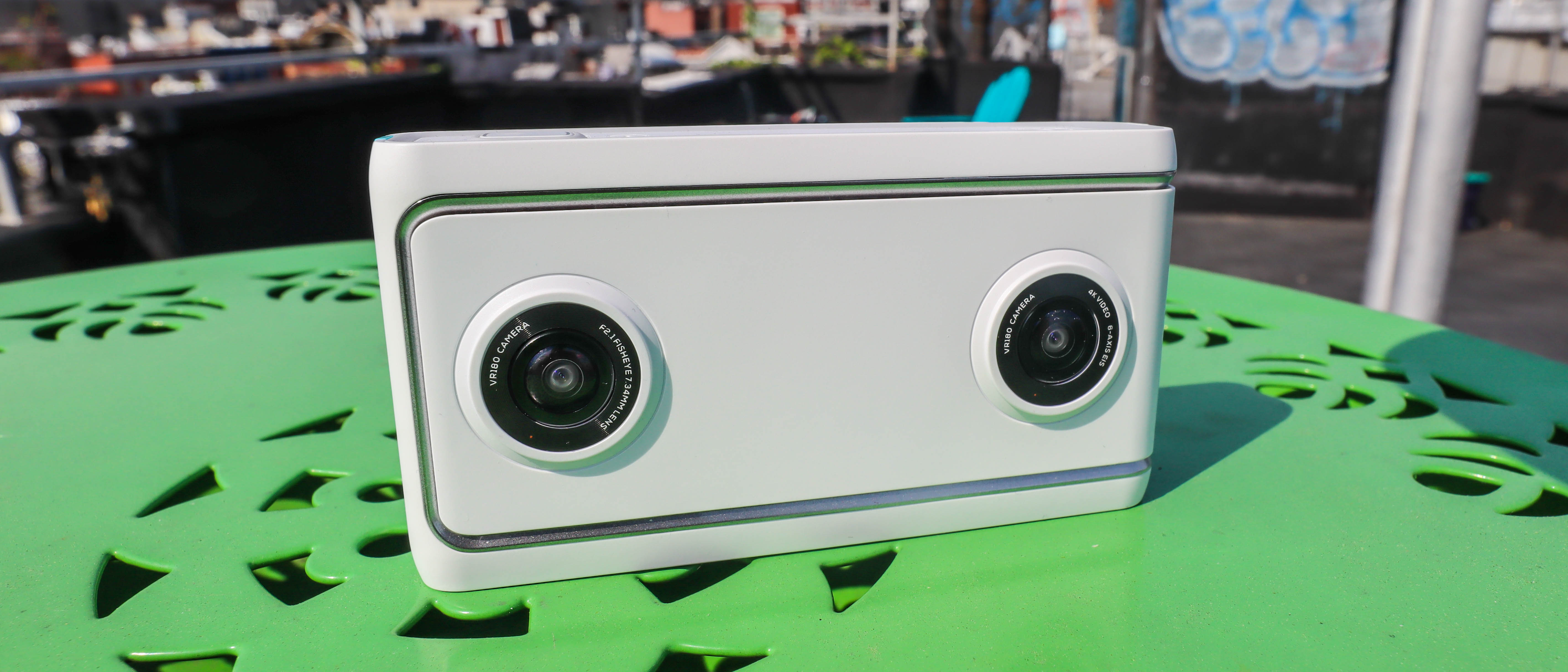TechRadar Verdict
The unique Lenovo Mirage Camera records 180-degree video for a super-wide and 3D view of the world. Its simplicity compared to the many 360-degree cameras out now gives it more mainstream appeal than a full 360 video for both the shooter and the watcher, though it's a little too simple without a screen on the back and YouTube's lousy compression is easy to spot.
Pros
- +
Easier to use than a 360 camera
- +
YouTube VR180 integration
- +
Compact, pocketable design
Cons
- -
YouTube video compression issues
- -
No screen on back
- -
Easy to get your fingertips in shot
- -
As expensive as 360 cameras
Why you can trust TechRadar
The Lenovo Mirage Camera eschews the idea of capturing 360-degree video and, instead, focuses on recording sometimes brilliant-looking, though far-too-inconsistent, 180-degree footage in 3D.
We tested this Daydream VR- and Lenovo Mirage Solo-supported camera and can firmly say that '180' doesn't always mean it's half as good as the best 360 cameras available. In fact, for a lot of people, it's going to be simpler to use and better than a 360-degree camera.
This compact, point-and-shoot style camera has two 13MP fisheye lenses on the front, and although it's very easy to get your fingertips in the shot, they give you a whole new way to capture the broad world in front of you. Creators have a new tool to differentiate their normally flat-looking videos.

Lenovo and YouTube are out to prove that there's room in between normal 2D video and 360-degree video. But VR180 isn't for everyone – or even most people. There's no screen on back and it's still as expensive as many 360-degree cameras, many of which can shoot 180-degree video with a simple settings switch.
The VR180 format – although inconsistent – is what helps set the Lenovo Mirage Camera apart from the competition. It's the right idea for cutting-edge creators seeking a simple, pocketable camera that adds more depth to their content, but it's also very much a 'Generation 1.0' product.
Price and release date
The Lenovo Mirage Camera is now available in the US and costs $299 (about £220, AU$400). There are two ways to look at this price.

It's just as expensive the best 360-degree cameras out there. It's a harder sell when you realize that many of 360 cameras, including Samsung Gear 360 can shoot 180-degree video with a simple settings switch.
Sign up for breaking news, reviews, opinion, top tech deals, and more.
The true selling points for the Mirage Camera are its native VR180 support and ease-of-use. It's the anti-360-degree camera in that doesn't resemble an off-putting, alien-probe-like camera. The friendly, old-school digital camera design is a big plus.
Design
The Mirage Camera is shaped like a compact and lightweight point-and-shoot digital camera that you gave up buying years ago – but one without a display on back and two 13MP camera lenses in front. They look very much like beady eyes, but that's the magic behind being able to shoot super-wide 3D photos and video in a literal snap.

It's also easier for your viewers to understand where you want them to look. 360-degree video can be a bit complex to shoot, edit (file sizes are huge) and watch.
There's a familiar shutter button on the top right and a 1/4-inch screw hole for a tripod on the bottom. The removable battery that lasts two hours and charges via USB-C. It'll fit right in your pocket, unlike Samsung's bulbously first-generation 360-degree camera, for example.

We didn't need a microSD card right away, much to our delight. There's 16GB of internal storage and the ability to add up to 128GB of additional space via a hidden microSD card slot.
We really like this feature, not just because of the expandable storage, but if you forget your microSD card at home (i.e. leave it in your computer... again), you can still snap ultra-wide photos and 180-degree video with the camera due to its internal storage. You won't see a "No microSD card" message. How many times has that happened to you? Even once is too much.

Picture quality and connected app
The Lenovo Mirage Camera is tightly integrated to YouTube and Google Photos, with video in the new YouTube VR180 format. We were able to view everything we shoot on a phone natively without special equipment. On a computer, we were able to see the video once we uploaded the raw, stereoscopic files to YouTube.
You don't need a VR headset like you would to properly experience a constant head-turning 360-degree video. You can simply drag your computer mouse or use a phone touchscreen a little bit left or a little bit right and up and down to peer at the 180-degree world. Of course, Lenovo would love it if you did chose VR and used its new Lenovo Mirage Solo standalone Daydream VR headset.
The 4K resolution video can look brilliant or inconsistent, often depending on where you see the video. On our small phones, watching the 180-degree video natively, everything is clean and moved fluidly for the most part. There's some tearing and popping when briskly walking with the fisheye camera and certainly no HDR video here, but the raw quality is on par with other 360-degree cameras we've tested.
On YouTube, it's far too easy to the jaggy, pixelated compression that's going on. We hope this can be corrected over time as YouTube perfects its VR180 format. It's also still too easy to get lost when moving the 180-degree video around. It's technically showing 360 degrees of panning, as blackness shrouds half of the 360 world. It's a shame because we know our videos look better and are easier to control on the phone. Everyone who sees their video only on YouTube may come to hate this device.
The raw photo and video files on a phone look acceptable at least, and it's easy to make them look better when adjusting the camera controls from the phone app. You have control over the white balance, ISO, and resolution. There are also five different filters.
We were able to easily switch between photo and video modes with a function key on the actual camera hardware. You can launch YouTube Live video through the app, too. There's a lack of signage that says whether or not this is working, but after the fact, we found out our Live broadcast did work.
Going along with its ease-of-use mantra, we found that the Lenovo Mirage Camera file sizes are extremely small, usually between 3MB and 4MB for photos, and 66MB for 30 seconds of video. That's been a huge problem for high-end 360 cameras.
Here's where the Lenovo Mirage Camera gets complicated. Without the viewfinder on back, you can't frame your shot. The argument is that it really doesn't matter thanks to the super-wide aspect ratio. But we found our fingertips in plenty of the VR180 content we captured – so it does matter. It's unfortunate.
You can always pair a smartphone to this 3D camera via Wi-Fi Direct. But we've been through this before with screen-less GoPros. Having to use a phone as a viewfinder is a cumbersome process, even if this device does an admirable job as keeping the in sync (bye, bye, bye is what some people still say without the screen).
Everything else about the Mirage Camera is rather simple. Maybe a bit too simple at times. There's no native time-lapse video option, which would have been ideal on an immersion-driven device like this, and we had trouble connecting the Mirage Camera to the Wi-Fi at our office – the app had let us connect to a Wi-Fi SSID and a field for the password. Our office requires a username as well, so we had to try Wi-Fi-required YouTube Live streaming at home.
Battery life
The Lenovo Mirage is rated to last two hours on a single charge and can recharge via USB-C. Obviously recording 4K cut down on this two hours considerably. Capturing two dozen two-minute video clips over 90 minutes drained the battery completely.

Thankfully, we were able to pop out the 2,200 mAh battery, and the package we got came with two batteries inside, lending itself to be a very battery-swappable 360-degree camera. That's extremely rare in 2018.
We do wish that there was a time-lapse mode. The camera could potentially last much longer and cut down on our post-capture editing time, too.
Verdict
The Lenovo Mirage Camera captures 180-degree video in a 360-degree world – and in a world where there are so many 360 cameras. The fact that these rival cameras can record 180-degree video doesn't help Lenovo's case.

However, we see the appeal behind the simplicity of the Mirage Camera. It's small, lightweight and acts like a point-and-shoot camera with powerful fisheye lenses. The results give you super-wide 3D video and photos in the new VR180 format.
The Mirage Camera makes it easier for every day content creators to capture wider video, and for a mainstream audience to watch it. But it's not perfect. We find YouTube's video quality compression and the lack of a built-in screen on the camera troubling. It's very much for early adopters who are willing to go through these pain points simply because the idea, not always the execution, is great.

